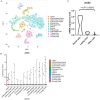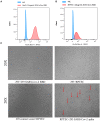ACE2 Expression in Kidney and Testis May Cause Kidney and Testis Infection in COVID-19 Patients
- PMID: 33521006
- PMCID: PMC7838217
- DOI: 10.3389/fmed.2020.563893
ACE2 Expression in Kidney and Testis May Cause Kidney and Testis Infection in COVID-19 Patients
Abstract
In December 2019, a new type of pneumonia caused by SARS-Cov-2 (COVID-19) occurred in Wuhan and has been discovered in many countries around the world. ACE2 (angiotensin-converting enzyme 2) has been shown to be one of the major receptors that mediate the entry of SARS-Cov-2 into human cells. Here in this study, we used the online datasets to analyze ACE2 expression in different human organs. The results indicated that ACE2 highly expresses in renal tubular cells, Sertoli cells, Leydig cells, and cells in seminiferous ducts in testis. Recombinant SARS-CoV-2 spike protein (RBD) domain and ACE2 of RPTEC/SerC cell-binding assays confirmed that SARS-Cov-2 can bind to ACE2 on the surface of these cells. Our results suggest that ACE2 expression could contribute to kidney and testis infection after COVID-19 infection. Renal function evaluation and special care should be performed during clinical work. Clinicians should also pay attention to the risk of testicular lesions in patients during hospitalization and later clinical follow-up, especially the assessment and appropriate intervention in young patients' fertility.
Keywords: ACE2; COVID-19; SARS-Cov-2; kidney; testis.
Copyright © 2021 Fan, Lu, Li, Ding and Wang.
Conflict of interest statement
The authors declare that the research was conducted in the absence of any commercial or financial relationships that could be construed as a potential conflict of interest.
Figures



References
-
- Chai X, Hu L, Zhang Y, Han W, Lu Z, Ke A, et al. Specific ACE2 expression in cholangiocytes may cause liver damage after 2019-nCoV infection. bioRxiv. (2020):2020.02.03.931766. 10.1101/2020.02.03.931766 - DOI
LinkOut - more resources
Full Text Sources
Other Literature Sources
Miscellaneous

